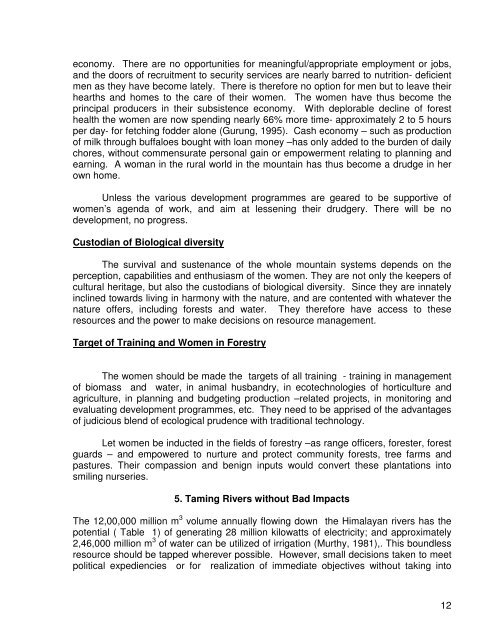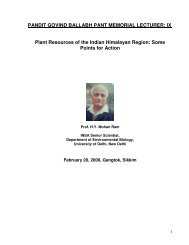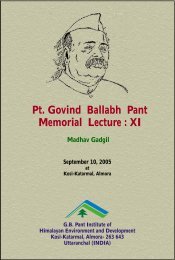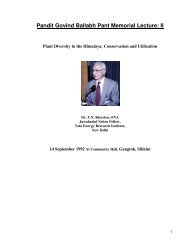PANDIT GOVIND BALLABH PANT MEMORIAL LECTURE: VII ...
PANDIT GOVIND BALLABH PANT MEMORIAL LECTURE: VII ...
PANDIT GOVIND BALLABH PANT MEMORIAL LECTURE: VII ...
You also want an ePaper? Increase the reach of your titles
YUMPU automatically turns print PDFs into web optimized ePapers that Google loves.
economy. There are no opportunities for meaningful/appropriate employment or jobs,<br />
and the doors of recruitment to security services are nearly barred to nutrition- deficient<br />
men as they have become lately. There is therefore no option for men but to leave their<br />
hearths and homes to the care of their women. The women have thus become the<br />
principal producers in their subsistence economy. With deplorable decline of forest<br />
health the women are now spending nearly 66% more time- approximately 2 to 5 hours<br />
per day- for fetching fodder alone (Gurung, 1995). Cash economy – such as production<br />
of milk through buffaloes bought with loan money –has only added to the burden of daily<br />
chores, without commensurate personal gain or empowerment relating to planning and<br />
earning. A woman in the rural world in the mountain has thus become a drudge in her<br />
own home.<br />
Unless the various development programmes are geared to be supportive of<br />
women’s agenda of work, and aim at lessening their drudgery. There will be no<br />
development, no progress.<br />
Custodian of Biological diversity<br />
The survival and sustenance of the whole mountain systems depends on the<br />
perception, capabilities and enthusiasm of the women. They are not only the keepers of<br />
cultural heritage, but also the custodians of biological diversity. Since they are innately<br />
inclined towards living in harmony with the nature, and are contented with whatever the<br />
nature offers, including forests and water. They therefore have access to these<br />
resources and the power to make decisions on resource management.<br />
Target of Training and Women in Forestry<br />
The women should be made the targets of all training - training in management<br />
of biomass and water, in animal husbandry, in ecotechnologies of horticulture and<br />
agriculture, in planning and budgeting production –related projects, in monitoring and<br />
evaluating development programmes, etc. They need to be apprised of the advantages<br />
of judicious blend of ecological prudence with traditional technology.<br />
Let women be inducted in the fields of forestry –as range officers, forester, forest<br />
guards – and empowered to nurture and protect community forests, tree farms and<br />
pastures. Their compassion and benign inputs would convert these plantations into<br />
smiling nurseries.<br />
5. Taming Rivers without Bad Impacts<br />
The 12,00,000 million m 3 volume annually flowing down the Himalayan rivers has the<br />
potential ( Table 1) of generating 28 million kilowatts of electricity; and approximately<br />
2,46,000 million m 3 of water can be utilized of irrigation (Murthy, 1981),. This boundless<br />
resource should be tapped wherever possible. However, small decisions taken to meet<br />
political expediencies or for realization of immediate objectives without taking into<br />
12











